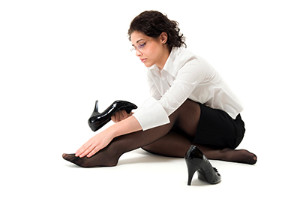 Wearing high heels commonly causes pain in the feet because the foot is forced into an unnatural position. Typically the top of the foot is put into an awkward position, as the heel is higher than the toes. Furthermore, the toes are usually forced into the small toe box and become cramped. Because of all this, the muscles around the ankles are commonly affected. Posture has to be continually changed to maintain balance, as high heels tend to push the center of gravity forward. Chronic wearers may develop short muscles and tendons and may notice this when flat shoes are worn, resulting in pain in the calves. Recent research may suggest that the risk of arthritis is increased the longer high heels are worn. Some solutions include wearing thicker heels to promote balance, keeping the heels lower, and wearing soft insoles. Stretching exercises for the feet and calves are also recommended. Finally, try to avoid wearing heels for long periods of time and only wear them for special events.
Wearing high heels commonly causes pain in the feet because the foot is forced into an unnatural position. Typically the top of the foot is put into an awkward position, as the heel is higher than the toes. Furthermore, the toes are usually forced into the small toe box and become cramped. Because of all this, the muscles around the ankles are commonly affected. Posture has to be continually changed to maintain balance, as high heels tend to push the center of gravity forward. Chronic wearers may develop short muscles and tendons and may notice this when flat shoes are worn, resulting in pain in the calves. Recent research may suggest that the risk of arthritis is increased the longer high heels are worn. Some solutions include wearing thicker heels to promote balance, keeping the heels lower, and wearing soft insoles. Stretching exercises for the feet and calves are also recommended. Finally, try to avoid wearing heels for long periods of time and only wear them for special events.
High heels have a history of causing foot and ankle problems. If you have any concerns about your feet or ankles, contact Dr. David Ungar from Personal Foot Care. Our doctor can provide the care you need to keep you pain-free and on your feet.
Effects of High Heels on the Feet
High heels are popular shoes among women because of their many styles and societal appeal. Despite this, high heels can still cause many health problems if worn too frequently.
Which Parts of My Body Will Be Affected by High Heels?
- Ankle Joints
- Achilles Tendon – May shorten and stiffen with prolonged wear
- Balls of the Feet
- Knees – Heels cause the knees to bend constantly, creating stress on them
- Back – They decrease the spine’s ability to absorb shock, which may lead to back pain. The vertebrae of the lower back may compress.
What Kinds of Foot Problems Can Develop from Wearing High Heels?
- Corns
- Calluses
- Hammertoe
- Bunions
- Morton’s Neuroma
- Plantar Fasciitis
How Can I Still Wear High Heels and Maintain Foot Health?
If you want to wear high heeled shoes, make sure that you are not wearing them every day, as this will help prevent long term physical problems. Try wearing thicker heels as opposed to stilettos to distribute weight more evenly across the feet. Always make sure you are wearing the proper shoes for the right occasion, such as sneakers for exercising. If you walk to work, try carrying your heels with you and changing into them once you arrive at work. Adding inserts to your heels can help cushion your feet and absorb shock. Full foot inserts or metatarsal pads are available.
If you have any questions please feel free to contact our office located in Farmington, MI . We offer the newest diagnostic and treatment technologies for all your foot and ankle needs.

